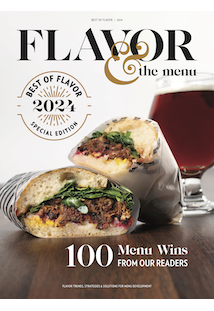
In April 2022, Esquire magazine declared the arrival of “The New Golden Age of the American Steakhouse,” noting the resilience of this enduring dining concept as it faces down an array of contemporary challenges, including plant-based zeal, climate change backlash, skyrocketing price increases and COVID-era closures. This renaissance is credited to the imagination, ambition and commitment of chefs who recognize the deep potential of the steakhouse concept and seek to forge a stronger link to fine dining and elevated menus.
Trend-watchers cite a number of areas for opportunity, including supplementing traditional favorites with unconventional cuts and smaller portions; establishing a broader menu of supporting players for both entrees and sides; offering more shareables; and highlighting creative preparation techniques and service presentations.
Chef Jesse Moore, Cargill Corporate Chef, notes that the pandemic gave rise to a generation of home cooks that learned how to prepare the perfect steak, and this puts new pressure on today’s steakhouses. “Chefs and operators must contend with a higher expectation for both quality and something new—at reasonable prices. But we still need to cover our costs and make a margin,” he says. These intricacies add up to a challenge that requires little shifts in longstanding menu approaches in order to stay with the pack.
Beef: First, Last, Always
Despite general declines in beef consumption in recent years, 2022 research from Datassential shows that beef remains the second-most popular protein in foodservice and tracks four-year growth in more than 20 categories of cuts and preparations, from braised beef (+25 percent), grilled rib eye and braised short rib (both +23 percent) to brisket (+22 percent), bone marrow (+16 percent), tri tip (+5 percent) and flank steak (+4 percent). A new generation of diners is proving open to the exploration of a variety of cuts (knuckle bones, shank and flank land in the inception and adoption menu trend categories) and dishes, especially those with a global connection, such as barbacoa, guisada and osso buco, among many others.
The Sterling Silver Premium Meats brand resonates with operators in the vanguard of what some are calling a “third wave” in steakhouse dining. Its line of premium beef cuts inspires the culinary craftsmanship that is the hallmark of chef-driven establishments. “Sterling Silver provides many cuts that can be showcased in a modern day steakhouse, such as smoked tri tips, bottom round flats cooked rare and sliced, and chuck flats that are braised down and served over a whipped potato,” says Moore.
And while new cuts open up avenues for menu innovation, Sterling Silver hasn’t lost sight of the popularity of classic beef cuts, recognizing that these, too, serve as sources of fresh inspiration. “For instance, a chef can break down a strip loin into a Manhattan filet and a mini strip,” Moore notes. “Being able to hit that, where there’s a nice thickness, gives you the time you need to build flavors and avoid over-cooking the meat.”
He also points to a consumer desire for smaller portion sizes. “Thirty years ago, it was all about big steaks. Today, most people are seeking servings in the 4- to 10-oz. range, although there are still plenty who want that pound of steak.” Moore believes preferences for smaller portions reflect a higher priority for quality over quantity—and one most guests will happily pay for.

Today’s steakhouse menus aren’t limited to steak preparations. Here, Guinness bone-in short ribs are placed atop a celery root puree with charred broccolini. The dish is topped with frizzled onions and red micro greens.
Flavor Forward Across the Menu
Moore is excited about flavor trends that are at the heart of modern steakhouses. “Once again, 30 years ago, it was simply salt, pepper and garlic. Now you have flavors from around the world represented on steakhouse menus. It might be Moroccan or Syrian or a German-inspired sauerbraten,” he says. “The flavors you can get today are mind-blowing when you consider where we were not too long ago.”
He points to sauces as one area of flavor opportunity. “Menus still feature the classic sauces, but you also see a good number of compound butters, which I think are phenomenal to use,” Moore says. “The right compound butter can accompany so many dishes—steak, fish, the house special.” Today’s diners also demonstrate a greater sophistication and awareness of flavor sources. “Guests know what the Maillard reaction is, so they expect to have that delicious crust on a ribeye.” It puts a lot of pressure on the back-of-house staff to hit all the marks, he reports. “The perfect medium rare is no longer enough; the ante keeps being raised.”
Side dishes are another valuable driver for the modern steakhouse patron. “Baked potatoes, creamed spinach, sauteed mushrooms, asparagus with a hollandaise, the wedge salad—these classics by themselves won’t fly,” says Moore. “Now, it’s not just a baked potato, but a sweet potato—one that’s baked, cubed, fried or pureed. And along with asparagus, you need to consider broccolini, Brussels sprouts or a fried cauliflower.” But some of the earliest steakhouse classics, such as Hasselback or Dauphine potatoes, are enjoying their own revival, and reinvention is another tactic being put to good use. “A favorite side I recently enjoyed was a play on the classic creamed spinach. It was turned into a souffle, and it was great! It offered nostalgia for a simpler time with wonderful execution,” he says.
While center of the plate options have also expanded on modern steakhouse menus, beef remains at the core. The concept is still, a “steak” house, after all. With new products and new ways to use classic beef cuts, Sterling Silver Premium Meats can serve both veteran steakhouse operators and those “third wave” chefs eager to put their own stamp on the segment.
To learn more about creating great dining experiences, visit sterlingsilvermeats.com







